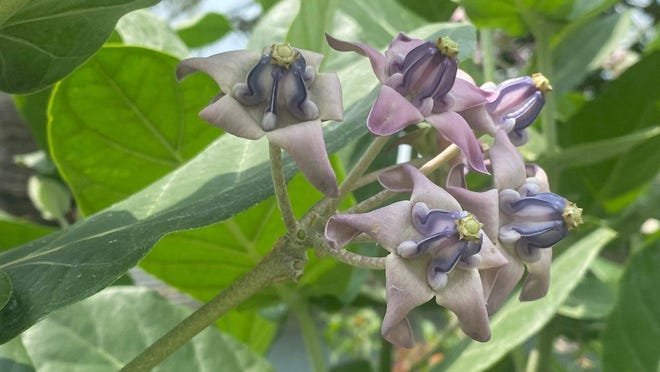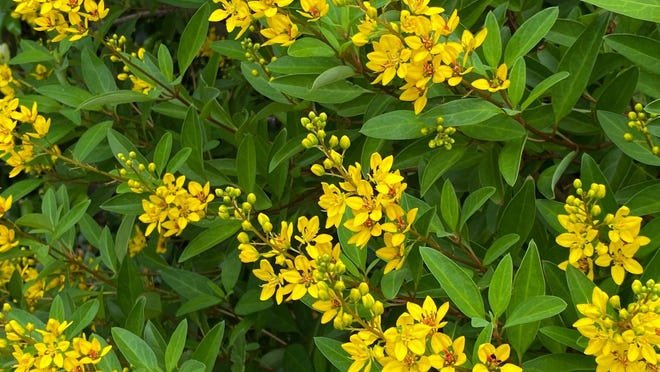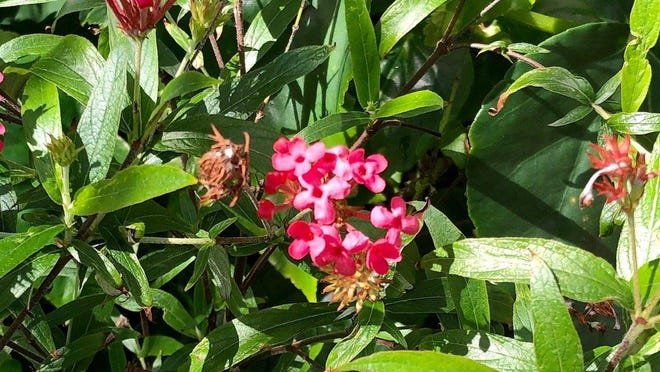Color your world with eco-friendly natives
Photo by Kim Frisbie
June 7, 2020
Genetically modified crops or organisms are confusing, so I thought I’d try to clarify a few of the basic tenets.
GMOs are the result of transferring DNA into a plant to alter its gene code, usually for herbicide resistance. Most genetically modified food crops are altered to withstand applications of the systemic herbicide glyphosate, the predominant ingredient in Roundup.
Glyphosate is sprayed across huge swaths of genetically modified crops, which remain unaffected while every other plant in the vicinity is killed. Intended to prevent unwanted weeds, the result has been the decimation of food plants for a huge number of bees, butterflies, pollinators and other insects.
Milkweed, the host plant for the monarch butterfly, used to grow rampantly along roadsides, in ditches, and throughout the corn and wheat belts of the Midwest. After the introduction of GMOs and the almost universal use of Roundup, milkweed has mostly disappeared — and along with it, about 90% of our monarch butterflies.
Host to the endangered monarch butterfly, milkweed is covered in clusters of bright orange red flowers.
Corn, soybeans, sugarbeets, alfalfa, cotton, canola, wheat and oats are just a few of the crops that are genetically modified to become “Roundup ready.”
Genetically engineered DNA can transfer from plants to bacteria and can persist in the soil for years. When it is taken up by natural soil bacteria, this DNA can transfer to bacteria in the human digestive system.
Glyphosate also remains in the soil, where, as a “probable human carcinogen,” it can easily enter our food supply. Long-term studies on its health effects are not required by regulators anywhere in the world. Industry studies are conducted by the corporations themselves, without review by independent scientists, and data may not be available for public access.
It is probably in your best interest to avoid genetically modified or engineered food whenever possible. On a happier note, planting natives will bring pollinators, butterflies, bees, and birds into your gardens.
Every insect, including those that sting and bite, plays an important ecological role. They provide food for millions of birds and animals, which in turn are eaten by larger predators. They decompose waste and carrion, unlocking essential nutrients for the surrounding ecosystem. They feed on crop-threatening pests, reducing the need for pesticides. They pollinate 90% of flowering species and 80% of crop species; without pollinators, we would have a drastically reduced food supply. And they aerate soil, helping to retain water and nutrients. It would behoove us to appreciate the importance of our choices, and to provide flowers and plants necessary for native birds and pollinators.
I’ve had several requests from people looking for color in their otherwise green landscapes. Here are some beautiful, low-maintenance natives and Florida-friendly plants that will give you endless color — and will bring butterflies, birds, hummingbirds and pollinators to your gardens.
And let me emphasize that you do NOT need to take everything out of your existing landscapes — just adding a few natives will give you tremendous results.
Florida firebush, Hamelia patens var patens, is an easy, productive, colorful native shrub that will reward you with a myriad of butterflies and songbirds, as well as hummingbirds. Clusters of reddish orange tubular flowers are present year-round, and if grown in full sun, the foliage will be tinged with red as well.
The Florida firebush is an easy, productive, colorful native shrub that attracts butterflies and songbirds, as well as hummingbirds.
Blue sage, Salvia azurea, will add a gorgeous azure blue to your garden, while attracting butterflies, birds and other pollinators. This likes full sun and is drought tolerant.
Tropical sage, Salvia coccinea, adds sprays of white, pink, and red, and spreads freely from seed. This is another must-have for butterfly and hummingbird enthusiasts. Both these salvias are natives.
Panama rose, Arachnothryx leucophylla, is an incredibly colorful shrub, sporting clusters of bright pink flowers that butterflies and ruby-throated hummingbirds can’t resist. Give it full sun, and once established, it will need little care. This can reach a height of 6-8 feet but can be pruned to a smaller size.
The Panama rose sports clusters of bright pink flowers that butterflies and ruby throated hummingbirds can’t resist.
Pineland strongback, Bourreria cassinifolia, is a rounded evergreen shrub with a dense canopy that can reach 8 feet in height. Producing small white flowers that bring in Julias, Gulf fritillaries, zebra longwings, sulphers, skippers and even sphinx moths, this can be used as a barrier screen or grown in a large patio planter. Find a sunny location for this state listed endangered species and enjoy the butterflies.
If you’re looking for a terrific native vine, wild allamanda, Pentalinon luteum, will give you the most glorious trumpetlike bright yellow blossoms from spring to fall. Plant this in full sun to climb over a trellis or archway, and in addition to the stunning color, you will attract numerous skippers and other butterflies.
Wild allamanda is noted for its trumpetlike bright yellow blossoms that bloom from spring to fall. This is a hearty climber that is loved by butterflies.
Milkweed has to be mentioned as the larval host to our monarch butterflies, which are in serious decline. Asclepias tuberosa, our native butterfly milkweed, is perfect for dry sunny locations, and is covered in clusters of bright orange red flowers. The monarch larvae (caterpillars) will quickly defoliate the plants as they munch their way through before forming their jewellike chrysalis. Don’t worry, these will come back again in a week or two; simply plant the milkweed behind some other plants so you won’t notice the barren stems. And the thrill of watching a monarch emerge from its chrysalis is well worth the price of a few defoliated plants. Make sure you purchase your plants from a reputable dealer – some milkweed has been pre-sprayed for “pests” and will kill any larvae that eat the foliage.
Giant milkweed, Calotropis gigantea, is not a native, but serves as a larval host for queen butterflies, and is an interesting addition to any garden for its purplish-white starlike flowers and large blue-gray leaves.
Giant milkweed has purplish-white starlike flowers and large blue-gray leaves.
Another great shrub for endless bright yellow color is slender goldshower, Galphimia gracilis, also known as thryallis. This is a fast grower, in full sun or part shade, and can be kept to 3 feet or allowed to grow up to 5-6 feet. The profuse, glorious yellow blooms will bring in plenty of butterflies and pollinators and will keep you smiling.
To see some of these plants (and many more fabulous natives) up close and personal, visit the Preservation Foundation’s Pan’s Garden, which reopened Monday.
-Kim Frisbie
Original article on the Palm Beach Daily News is HERE.















